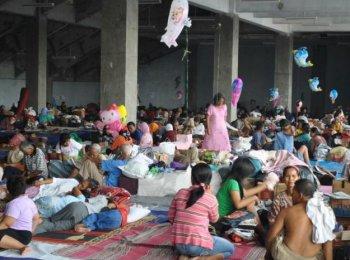SLEMAN, Indonesia—Mount Merapi is now calm, but as residents, government workers, and members of relief organizations work to clean up the destruction left in the volcano’s wake, life is far from back to normal. One task they must contend with is burning all the cattle that were killed during the eruptions.
Left unattended, cattle carcasses can cause outbreaks of infectious diseases, and the authorities and villagers are burning the dead cows and bulls.
“A great difficulty in the field are carcasses buried under the rubble of collapsed cowsheds, and it takes time to dig them out. In addition, adequate personnel are lacking. Ideally we need 10 teams, with five people on each team. Currently, we only have two teams to start with,” said Dr. Triwahana Adiwijaya, coordinator of field control of communicable diseases.
In the three days prior to the interview, the two teams assisted residents in burning approximately 147 cattle carcasses.
The head of Agricultural Department of Yogyakarta Province, Nanang Suwandi, said that 2,395 head of dead cattle have been counted at the time of the interview. Of the cattle that have been burned, only the charred bones remain.
However, the authorities and villagers have not yet been able to attend to many of the carcasses.
The residents and team members have been improvising, burning the cows with whatever materials available, such as used cooking fuel and debris from fallen buildings. However, the authorities are still seeking fuel, including used motor oil, tires, and diesel fuel.
To burn one cow takes up to three days, because the average weight of each cow is almost 700 pound. Burning can also require more than ten gallons of liquid fuel.
Sukamto, a resident of Balerante Village, said he and others from his locale have been burning 25-30 cows per day. “I feel as citizens of Balerante, we must do something,” said Sukamto. “We burn on the spot because it is not possible to remove the cows and bury then. We do not have the support facilities and manpower.”
Apart from burning the carcasses, the Department of Agriculture in Yogyakarta Province is using other methods to prevent disease outbreaks from the fallen cows.
When conditions permit, some carcasses are buried, but are first sprayed with antibacterials. The Department of Agriculture estimates that it will take two to three weeks to dispose of all the dead cows.
Left unattended, cattle carcasses can cause outbreaks of infectious diseases, and the authorities and villagers are burning the dead cows and bulls.
“A great difficulty in the field are carcasses buried under the rubble of collapsed cowsheds, and it takes time to dig them out. In addition, adequate personnel are lacking. Ideally we need 10 teams, with five people on each team. Currently, we only have two teams to start with,” said Dr. Triwahana Adiwijaya, coordinator of field control of communicable diseases.
In the three days prior to the interview, the two teams assisted residents in burning approximately 147 cattle carcasses.
The head of Agricultural Department of Yogyakarta Province, Nanang Suwandi, said that 2,395 head of dead cattle have been counted at the time of the interview. Of the cattle that have been burned, only the charred bones remain.
However, the authorities and villagers have not yet been able to attend to many of the carcasses.
The residents and team members have been improvising, burning the cows with whatever materials available, such as used cooking fuel and debris from fallen buildings. However, the authorities are still seeking fuel, including used motor oil, tires, and diesel fuel.
To burn one cow takes up to three days, because the average weight of each cow is almost 700 pound. Burning can also require more than ten gallons of liquid fuel.
Sukamto, a resident of Balerante Village, said he and others from his locale have been burning 25-30 cows per day. “I feel as citizens of Balerante, we must do something,” said Sukamto. “We burn on the spot because it is not possible to remove the cows and bury then. We do not have the support facilities and manpower.”
Apart from burning the carcasses, the Department of Agriculture in Yogyakarta Province is using other methods to prevent disease outbreaks from the fallen cows.
When conditions permit, some carcasses are buried, but are first sprayed with antibacterials. The Department of Agriculture estimates that it will take two to three weeks to dispose of all the dead cows.

